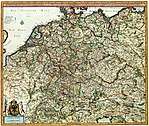Timeline of Augsburg
Prior to 16th century
Part of a series on the |
||||||||||
|---|---|---|---|---|---|---|---|---|---|---|
| History of Germany | ||||||||||
 | ||||||||||
| Topics | ||||||||||
| Early history | ||||||||||
| Middle Ages | ||||||||||
| Early Modern period | ||||||||||
| Unification | ||||||||||
|
||||||||||
| German Reich | ||||||||||
|
||||||||||
| Contemporary Germany | ||||||||||
|
||||||||||
|
| ||||||||||
- 14 BCE – Roman colony Augusta Vindelicorum established (approximate date).[1]
- 5th century CE – Settlement sacked by Huns.[1]
- 6th century CE - Catholic Diocese of Augsburg established.[2]
- 778 – Simpert becomes Bishop of Augsburg.
- 788 – Town sacked by forces of Charlemagne.[3]
- 923 – Ulrich becomes Bishop of Augsburg.
- 952 – Diet of Augsburg (meeting of leaders of Holy Roman Empire) active.
- 989 – Perlachturm built.
- 1065 – Augsburg Cathedral consecrated.[4]
- 1251 – Dominican Monastery of St. Katharine active.
- 1276 – Augsburg becomes a Free Imperial City.[1]
- 1300 – Barfüsserkirche (church) founded.[5]
- 1321 – St. Anna-Kirche (church) founded.[4]
- 1364 – Three Moors Inn in business (approximate date).[5]
- 1370 - Public clock installed (approximate date).[6]
- 1407 - Paper mill established.[7]
- 1431 – Augsburg Cathedral remodeled.[4]
- 1468 - Burkhard Zingg writes Augsburger Chronik, a history of the city (approximate date).
- 1472 – Printing press in operation.[8]
- 1487 - Fuggers Bank established.[9]
- 1493 – Artist Hans Holbein the Elder active (approximate date).[4]
- 1500 – Church of St. Ulrich and St. Afra built.[1]
16th–18th centuries
- 1502 – Catholic Holy Cross Church built.[4]
- 1509 – Fortunatus (story) published.
- 1515 – Dominikaner-Kirche (church) built.[4]
- 1517 - Fugger chapel built.[10]
- 1518 - Fire engine built.[11]
- 1523 – Fuggerei residential area developed.
- 1530 – Lutheran Confession of Augsburg introduced.[12]
- 1534 – Augsburg Protestant Cemetery established.
- 1537
- Staats- und Stadtbibliothek Augsburg (city library) founded.[13]
- Augsburg joins the Schmalkaldic League.
- 1540 – Augsburger Börse (stock exchange) established.
- 1546 – Boeck house[4] and Rotes Tor (gate)[4] built.
- 1573 - Sugar refinery begins operating.[14]
- 1577 – Imperial Abbey of Saints Ulrich and Afra active.
- 1582 – St. Salvator Jesuit school founded.[15]
- 1594 – Augustusbrunnen (fountain) created for Maximiliansstrasse.[5]
- 1599 – Herkulesbrunnen (fountain) created for Maximiliansstrasse.[5]
- 1607 – Augsburger Zeughaus (armory) built.[4]
- 1609 - Metzg (butchers' house) built.[4]
- 1612 – Engravers Lucas and Wolfgang Kilian in business.[16]
- 1620 – Augsburg Town Hall built.[1]
- 1631 - Augsburg Art Cabinet sent to Sweden as a gift.[17]
- 1632 – Swedish occupation begins.[1]
- 1635
- Swedish occupation ends.
- Population: 16,432.
- 1650 – Augsburger Hohes Friedensfest (festival) begins.
- 1703 – Town besieged by Bavarian forces.[3]
- 1712 – Academy of painting founded.[3]
- 1765 – Gignoux-Haus built.
- 1770 – Ballroom built in the Schaezlerpalais.[4]
- 1782 – Dollische bookseller in business.[18]
- 1786 - August: Air balloon flight of Joseph Maximilian Freiherr von Lütgendorf.[19]
19th century
- 1805 – 10 October: French in power.[3]
- 1806
- 4 March: Augsburg becomes part of the Kingdom of Bavaria.[1]
- Population: 26,200.
- 1810 – Allgemeine Zeitung (newspaper) in publication.[20]
- 1817 – Augsburg becomes an administrative capital of the Oberdonaukreis.
- 1825 – Chapel built in Protestant Cemetery.
- 1833 – Holbein-Gymnasium (school) established.
- 1837 – Town becomes administrative capital for the Swabia and Neuburg district.
- 1840
- Sander'sche Maschinenfabrik in business.
- Cotton mill established.[5]
- 1846 – Augsburg Hauptbahnhof (train station) opens.
- 1847
- Augsburg Morellstraße station opens.
- Turnverein Augsburg (sport club) formed.
- 1854 – Maximilian Museum founded.[4]
- 1858 - Population: 43,616.[21]
- 1870 – Konigl. Industrieschule (industrial school) established.[22]
- 1875 – Paar Valley Railway begins operating.
- 1876 – Der Volkswille newspaper in publication.[23]
- 1878
- Stadttheater Augsburg (theatre) built.[5]
- Augsburger Eislaufverein (ice hockey team) formed.
- 1885
- 1898 – Maschinenfabrik Augsburg-Nürnberg and Augsburg-Oberhausen Acetylene Factory in business.
- 1900 – Population: 89,109.[1]
20th century
- 1903 – TSV Schwaben Augsburg (football club) formed.
- 1905 - Population: 94,923.[25]
- 1907 – FC Augsburg (football club) formed.
- 1910
- Landsberg Prison established in vicinity of Augsburg.
- Population: 102,487.[26]
- 1911 – Oberhausen becomes part of Augsburg.
- 1917 - Augsburg Synagogue built.
- 1919 - Population: 154,555.[27]
- 1920 – Stadtbücherei Augsburg (public library) founded.
- 1924 – Augsburger Kajak Verein (kayak club) formed.[28]
- 1926 – Bayerische Flugzeugwerke (Bavarian Aircraft Works) in business.
- 1930 - 8 September: Hitler gives campaign speech.
- 1933 – Gau Swabia (Nazi administrative region) established.
- 1937
- Augsburg Zoo opens.[29]
- Mozarthaus (house museum) established.
- 1938
- Messerschmitt aircraft manufactory in business.
- Ice skating rink opens.
- 10 November: Synagogue destroyed during Kristallnacht.
- 1942 – 17 April: Bombing by Allied forces.
- 1944 – 25–26 February: Bombing by Allied forces.
- 1945 – Schwäbische Landeszeitung newspaper begins publication.[20]
- 1948
- Verlagsgruppe Weltbild (publisher) in business.
- Augsburger Puppenkiste (theatre) opens.
- 1951
- Rosenaustadion (stadium) opens.
- Town art collections installed in the Schaezlerpalais.
- 1954 - Fürst Fugger Privatbank established.
- 1956 – United States military 11th Airborne Division stationed in Augsburg.[30]
- 1961 - Population: 208,659.
- 1969 – Part of Göggingen becomes part of Augsburg.
- 1970 – University of Augsburg founded.
- 1971
- Augsburg Eiskanal (artificial whitewater river) opens.
- Augsburg University of Applied Sciences founded.
- 1972
- Inningen becomes part of Augsburg.
- Kongresshalle opens.
- Dorint Hotel Tower built.
- 1977
- Kulturhaus Kresslesmühle (cultural space) opens.[31]
- Romanistentheater (Augsburg) founded.
- 1989 – Sparkassen-Planetarium opens.
- 1996
- Kulturhaus Abraxas (cultural space) active.
- S’ensemble Theater founded.
- 1998 – Brechthaus (house museum) opens.
21st century
- 2008 – Kurt Gribl becomes mayor.[32]
- 2009 – Stadtbücherei Augsburg (public library) building opens.
- 2012 – Population: 272,699.
See also
- Augsburg history
- List of mayors of Augsburg
- Diet of Augsburg
- List of heritage sites in Augsburg
- Timelines of other cities in the state of Bavaria: Munich, Nuremberg, Würzburg
References
- Britannica 1910.
- "Chronology of Catholic Dioceses: Germany". Norway: Oslo katolske bispedømme (Oslo Catholic Diocese). Retrieved 30 September 2015.
- George Henry Townsend (1867), "Augsburg", A Manual of Dates (2nd ed.), London: Frederick Warne & Co.
- Baedeker 1914.
- Murray 1903.
- Gerhard Dohrn-van Rossum (1996). History of the Hour: Clocks and Modern Temporal Orders. University of Chicago Press. ISBN 978-0-226-15510-4.
- Wilhelm Sandermann (2013). "Beginn der Papierherstellung in einigen Landern". Papier: Eine spannende Kulturgeschichte (in German). Springer-Verlag. ISBN 978-3-662-09193-7. (timeline)
- Henri Bouchot (1890). H. Grevel (ed.). The book: its printers, illustrators, and binders, from Gutenberg to the present time. London: H. Grevel & Co.
- Glyn Davies; Roy Davies (2002). "Comparative Chronology of Money" – via University of Exeter.
- "Central Europe (including Germany), 1400–1600 A.D.: Key Events". Heilbrunn Timeline of Art History. New York: Metropolitan Museum of Art. Retrieved 30 September 2015.
- Patrick Robertson (2011). Robertson's Book of Firsts. Bloomsbury. ISBN 978-1-60819-738-5.
- Benjamin Vincent (1910), "Augsburg", Haydn's Dictionary of Dates (25th ed.), London: Ward, Lock & Co.
- Julius Petzholdt (1853), "Augsburg", Handbuch Deutscher Bibliotheken (in German), Halle: H.W. Schmidt, OCLC 8363581
- Ursula Heinzelmann (2008). "Timeline". Food Culture in Germany. Greenwood Press. ISBN 978-0-313-34495-4.
- Gernot Michael Müller, ed. (2010). Humanismus und Renaissance in Augsburg [Humanism and the Renaissance in Augsburg] (in German). Walter de Gruyter. ISBN 978-3-11-023124-3.
- H. P. R (June 1927), Bulletin of the Museum of Fine Arts, 25, Boston: Museum of Fine Arts, Boston, pp. 37–38, JSTOR 4170056
- "Central Europe (including Germany), 1600–1800 A.D.: Key Events". Heilbrunn Timeline of Art History. New York: Metropolitan Museum of Art. Retrieved 30 September 2015.
- Allgemeines Adreßbuch für den deutschen Buchhandel ... 1870 (in German). Leipzig: O.A. Schulz. 1870.
- Richard Holmes (2013). Falling Upwards: How We Took to the Air. Knopf. ISBN 978-0-307-90870-4.
- "Global Resources Network". Chicago, USA: Center for Research Libraries. Retrieved 10 December 2013.
- "Germany: States of South Germany: Bavaria". Statesman's Year-Book. London: Macmillan and Co. 1869. hdl:2027/nyp.33433081590337.
- Königliche Museen zu Berlin (1904). Kunsthandbuch für Deutschland (in German) (6th ed.). Georg Reimer.
- Universitätsbibliothek. "Augsburger Zeitungen" [Newspapers of Augsburg] (in German). Universität Augsburg. Retrieved 10 December 2013.
- "Aufgaben und Geschichte des Stadtarchivs" (in German). Stadt Augsburg. Retrieved 10 December 2013.
- "German Empire". Statesman's Year-Book. London: Macmillan and Co. 1908. hdl:2027/nyp.33433081590592 – via HathiTrust.
- "Germany". Statesman's Year-Book. London: Macmillan and Co. 1915. hdl:2027/njp.32101072368358.
- "Germany". Statesman's Year-Book. London: Macmillan and Co. 1921. hdl:2027/njp.32101072368440.
- "Augsburger Kajak Verein" (in German). Augsburg. Retrieved 10 December 2013.
- Vernon N. Kisling, ed. (2000). "Zoological Gardens of Germany (chronological list)". Zoo and Aquarium History. USA: CRC Press. ISBN 978-1-4200-3924-5.
- "11th Airborne vets return to Germany". United States Army. 2009. Retrieved 10 December 2013.
- "Porträt und Bilder" (in German). Augsburg: Kulturhaus Kresslesmühle. Retrieved 10 December 2013.
- "German mayors". City Mayors.com. London: City Mayors Foundation. Retrieved 10 December 2013.
- This article incorporates information from the German Wikipedia.
Bibliography
in English
- published in the 17th-19th century
- Thomas Nugent (1749), "Augsburg", The Grand Tour, 2: Germany and Holland, London: S. Birt, hdl:2027/mdp.39015030762572
- Monsieur de Blainville (1757), "Augsburg", Travels through Holland, Germany, Switzerland, but especially Italy, Translated by Turnbull, London: John Noon
- "Augsburg". A Geographical, Historical and Political Description of the Empire of Germany, Holland, the Netherlands, Switzerland, Prussia, Italy, Sicily, Corsica and Sardinia: With a Gazetteer. London: John Stockdale. 1800. OCLC 79519893.
- David Brewster, ed. (1830). "Augsburg". Edinburgh Encyclopædia. Edinburgh: William Blackwood.
- Frances Trollope (1838), "Augsburg", Vienna and the Austrians, London: R. Bentley, OCLC 2431804
- Charles Knight, ed. (1866). "Augsburg". Geography. English Cyclopaedia. 1. London: Bradbury, Evans, & Co. hdl:2027/nyp.33433000064786.
- "Augsburg", Bradshaw's Illustrated Hand-book to Germany, London: W.J. Adams & Sons, 1873
- Lewis, "The Roman Antiquities of Augsburg and Ratisbon", in volume xlviii, Archæological Journal, (London, 1891).
- published in the 20th century
- "Augsburg". Handbook for Travellers in South Germany and Austria (15th ed.). London: J. Murray. 1903.
- "Augsburg", Encyclopædia Britannica (11th ed.), New York, 1910, OCLC 14782424
- Joseph Lins (1913). "Diocese of Augsburg". Catholic Encyclopedia. New York.
- "Augsburg", Southern Germany (Wurtemberg and Bavaria) (12th ed.), Leipzig: Karl Baedeker, 1914, OCLC 2011248
- Franz Grenacher (1968). "Guide to the Cartographic History of the Imperial City of Augsburg". Imago Mundi. 22: 85–106. doi:10.1080/03085696808592321. JSTOR 1150439.
- Trudy Ring, ed. (1995). "Augsburg". Northern Europe. International Dictionary of Historic Places. Fitzroy Dearborn. ISBN 978-1-136-63944-9.
- published in the 21st century
- John M. Jeep, ed. (2001). "Augsburg". Medieval Germany: an Encyclopedia. Garland Publishing. ISBN 0-8240-7644-3.
in German
- "Augsburg". Topographia Sueviae. Topographia Germaniae (in German). Frankfurt. 1643. p. 8+.
- Paul von Stetten (1779), Kunst-, Gewerb- und Handwerks Geschichte der Reichs-Stadt Augsburg (in German), Augsburg: C.H. Stage
- Augsburgs geschichte. 1826.
- Augsburg. Die Chroniken der Deutschen Städte (in German). 4-5, 22-23, 25, 29, 32. Leipzig: S. Hirzel Verlag. 1865–1917 – via HathiTrust.
- "Augsburg". Brockhaus' Konversations-Lexikon (in German) (14th ed.). Leipzig: Brockhaus. 1896. hdl:2027/njp.32101064064437.
- Werner, Geschichte der Stadt Augsburg, (Augsburg, 1900).
- Christian Meyer (1907), Geschichte der Stadt Augsburg (in German), Tübingen: H. Laupp, OCLC 163258088, OL 24871238M
- P. Krauss; E. Uetrecht, eds. (1913). "Augsburg". Meyers Deutscher Städteatlas [Meyer's Atlas of German Cities] (in German). Leipzig: Bibliographisches Institut.
- Wolfgang Adam; Siegrid Westphal, eds. (2012). "Augsburg". Handbuch kultureller Zentren der Frühen Neuzeit: Städte und Residenzen im alten deutschen Sprachraum (in German). De Gruyter. ISBN 978-3-11-029555-9.
External links
| Wikimedia Commons has media related to Augsburg. |
- Links to fulltext city directories for Augsburg via Wikisource
- Europeana. Items related to Augsburg, various dates
- Digital Public Library of America. Items related to Augsburg, various dates
This article is issued from Wikipedia. The text is licensed under Creative Commons - Attribution - Sharealike. Additional terms may apply for the media files.
